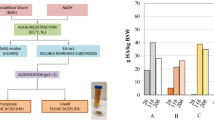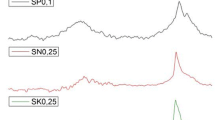Abstract
The total acidity of humic materials obtained by oxidation of kraft black liquors was previously found to have a very important effect on the results of their ammoniation process (which yields nitrogenous humic fertilizers). This paper deals with a further study of the ammoniation process of two humic materials (with 20 and 60 ml NaOH 0.1 N/g of sample of total acidity) by using liquid NH4OH. The influence of four independent variables (NH4OH concentration, reaction temperature, NH4OH/humic material ratio and reaction time) on the reaction yield, total and ammoniacal nitrogen content of the fertilizers was studied. A 24 factorial design was followed to carry out the experiments. Four models equations, which establish a quantitative relation between the independent and the dependent variables, for each kind of humic material, were found as a result of this work.
Similar content being viewed by others
References
Box GEP, Hunter WG and Stuart J (1986) Statistics for experimenters: An introduction to design, analysis and model building. New York: John Wiley and Sons.
Boy VM and Guijosa M (1981) Ammonia-selective electrode determination of nitrogen fertilizers. J. Assoc. Off. Anal. Chem. 64, 5: 1096–1099.
Coca J, Alvarez R and Fuertes AB (1984) Production of a nitrogenous humic fertilizer by the oxidation-ammoniation of lignite. Ind. Eng. Chem. Prod. Res. Dev., 23: 620–624.
Davies ROE and Scholl W (1939) Ammoniated peat. Effect of varying the conditions of ammonia treatment of nitrogen quality. Ind. Eng. Chem. 32: 185–190.
Eberhard WA, Lewis JL, Scharp RA and Barton CA (1978) Conversion of sulfite pulping waste to an agricultural product. J. Water Poll. Cont. Fed. 8: 1893–1904.
Eastin EF (1976) Use of ammonia electrode for total nitrogen determination in plants. Soil Sci. Plant Anal., 7: 477–481.
Goldstein IS (1981) Organic chemicals from biomass. Boca Raton: CRC Press.
González C, Alvarez R and Coca J (1992) Use of kraft black liquors from a pulp mill for the production of soil conditioners. Waste Manag. & Res., 10: 195–201.
Greenland DJ and Hayes MHB (1978) The Chemistry of Soil Constituents. New York: John Wiley and Sons.
Navarro RA and Rojas P (1984) Determination of ammoniacal and total nitrogen in fertilizer by ammoniaselective electrode. J. Assoc. Anal. Chem. 67, 5: 890–892.
Official Methods of Analysis, AOAC (1975). Washington: Williams Horwitz.
Peña D (1986) Estadística: Modelos y métodos. 1. Fundamentos. Madrid: Alianza Editorial.
Rodier J (1981) Análisis de aguas. Barcelona: Omega.
Walpole RE and Myers RH (1987) Probabilidad y estadística para ingenieros. Mexico: Interamericana.
Author information
Authors and Affiliations
Rights and permissions
About this article
Cite this article
González, C., Alvarez, R. & Coca, J. Waste kraft black liquors as raw material for the production of nitrogeneous humic fertilizers by an oxidation-ammoniation process. Fertilizer Research 33, 279–285 (1992). https://doi.org/10.1007/BF01050883
Received:
Accepted:
Issue Date:
DOI: https://doi.org/10.1007/BF01050883




